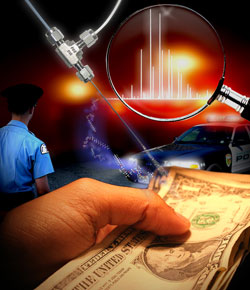A simple and fast technique to examine the surface of banknotes and identify counterfeits has been developed by scientists in Brazil and the US.
The counterfeiting of banknotes is a global problem that is increasing in scale and sophistication. Counterfeiters now use computerised reproduction methods like scanners and laser printers to copy real notes, and gone are the days when a fake could be spotted by simply testing the look and feel of the paper.
The new technologies used by counterfeiters have thrown out a challenge to law enforcement. 'Forensic laboratories are therefore confronted with an increasing demand to analyse larger numbers of samples with faster responses and reliable verdicts for samples fabricated with greater sophistication than ever,' says Marcos Eberlin, one of the researchers at the University of Campinas, Brazil.
With Graham Cooks at Purdue University in West Lafayette, US, Eberlin and colleagues have devised a mass spectrometric technique that can give a chemical profile of banknotes in seconds. There is almost no sample preparation required, it is non-destructive, and the test can also reveal which counterfeit method was used to create the 'funny money'.

Mass spectrometry detects fake notes
|
This new technique relies on using desorption ionisation mass spectrometry to test different spots on the banknote. The real banknotes show similar data (m/z ions), distributed evenly over the entire surface, despite age, denomination and colour pattern. This provides a fingerprint for the real banknotes. When the laserjet and inkjet notes are tested, a distinct set of ion markers can be seen and their fingerprint is quite different from the real money.
'The work convincingly demonstrates a relevant application of these techniques in combating currency forgery,' comments Niamh Nic Daeid, a forensic chemist at the University of Strathclyde in the UK. 'The next challenge will be to make this technology widely available to the forensic community as a robust and affordable technique.'
As well as discovering fake money, Eberlin can see this method being used in a preventative way. 'We are already working together with the Brazilian Federal Police and the manufactures in Brazil to find the most effective way to add these chemical signatures, either in ink formulations or as invisible stamps or bar codes, as a new and hard to imitate security measure for Brazilian banknotes,' he says.
Rebecca Brodie
Enjoy this story? Spread the word using the 'tools' menu on the left or add a comment to the Chemistry World blog.




